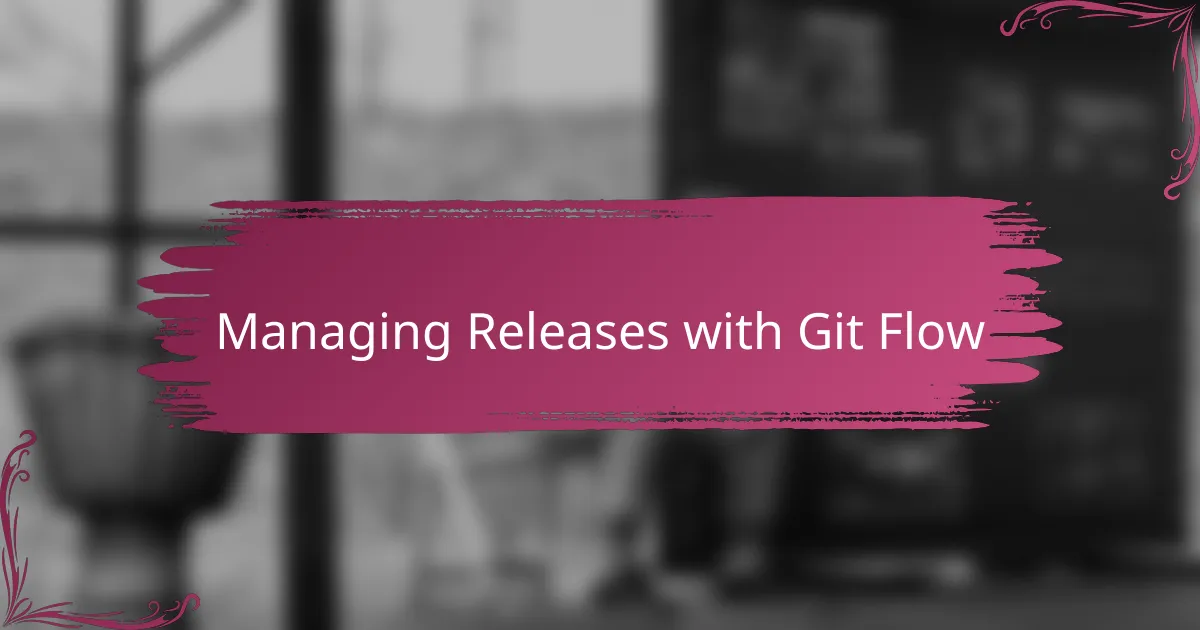Key takeaways
- Git Flow enhances project organization by using distinct branches for features, releases, and hotfixes, promoting stability and reducing merge conflicts.
- Best practices in Git Flow include focused commits, regular syncing of branches, and clear naming conventions to improve collaboration and communication among team members.
- Utilizing release and hotfix branches allows for thorough testing and quick responses to critical bugs, maintaining high quality and user trust during the development process.
- Effective integration of Git Flow within teams enhances clarity, responsibility, and communication, transforming chaotic workflows into structured collaboration.

Introduction to Git Flow
Git Flow quickly became my go-to strategy when managing project versions—it’s a branching model designed to keep development organized and efficient. Have you ever felt overwhelmed juggling multiple features and fixes at once? That was exactly my experience before I discovered Git Flow’s clear separation of work through dedicated branches.
What I appreciate most about Git Flow is its simplicity in handling release cycles and hotfixes without losing track of progress. It feels like having a roadmap during a complex journey, giving me confidence that my codebase stays stable while development moves forward. This approach transformed the way I approach coding projects, making collaboration smoother and reducing those dreaded merge conflicts.

Understanding Git Flow Branches
When I first started using Git Flow, understanding the purpose of each branch was a bit like learning a new language. The main branches—master and develop—act like the backbone of the project. Master holds the production-ready code, while develop is where I integrate all the new features before they’re polished enough to ship.
Feature branches quickly became my safe zones for experimenting, allowing me to work on one idea at a time without disturbing the overall flow. I remember feeling a sense of relief knowing that if something went wrong during a feature build, it wouldn’t bring down the entire project. Doesn’t having that kind of safety net make development less stressful?
Then there are release and hotfix branches, which I came to appreciate especially when deadlines loom or bugs pop up unexpectedly. Creating a release branch helps me prep for a new version without halting ongoing development, and hotfix branches let me address critical issues immediately. These branches gave me a structure that felt both flexible and reliable—a perfect balance when managing real-world projects.

Setting Up Git Flow in Projects
Setting up Git Flow in my projects always starts with installing the Git Flow extensions—it’s a straightforward step but really sets the foundation. Have you ever hesitated before adding new tools, worrying they might complicate things? I felt the same, but Git Flow’s setup is surprisingly smooth, and it just fits naturally into the workflow.
Once I have Git Flow initialized in the repository, I configure the default branch names to match the project’s conventions. This small customization makes a big difference later on, saving me from confusion when switching between branches. It feels like setting clear signposts before starting a long trip, giving me a sense of control right from the beginning.
I also remember the first time I created my initial feature branch using Git Flow commands—it was satisfying to see the branching structure take shape so easily. That moment made me realize how much this setup simplifies managing multiple parallel developments, keeping everything tidy without extra effort. Have you tried it yet? It might just change how you think about project organization.

Best Practices for Git Flow Workflow
One thing I’ve learned is to keep commits focused and meaningful within each Git Flow branch. When I avoid mixing unrelated changes, it’s much easier to review code and track down issues later. Have you ever tried digging through a massive commit only to get lost? Keeping things tidy feels like giving your future self a huge favor.
I’ve also found that regularly syncing develop with feature branches prevents a world of headaches. Merging early and often helps me catch conflicts before they snowball, which saves time and frustration. It’s a bit like clearing debris off the road before the big race rather than dealing with a pileup at the finish line.
Lastly, naming conventions in Git Flow have been a real game-changer for me. Using clear, descriptive branch names makes collaborating with others smoother and keeps miscommunication at bay. When everyone knows exactly what a branch is for, the whole team moves faster and with more confidence. Doesn’t that sound like the workflow we all want?

Managing Releases with Git Flow
When it comes to managing releases with Git Flow, I’ve found that release branches are an absolute lifesaver. They create a dedicated space for polishing the next version without disrupting ongoing development—a bit like having a rehearsal before the big performance. Have you ever tried finalizing features while juggling new changes? Release branches make that chaos feel manageable.
Preparing a release branch gives me the chance to test thoroughly, fix bugs, and update documentation without rushing. It’s a moment to pause and focus on quality, which builds my confidence before pushing to production. Plus, merging the release back into both master and develop feels like crossing a finish line after a well-run race.
Of course, there’s always the chance a critical bug pops up after a release. That’s when hotfix branches come to the rescue. They let me tackle urgent fixes immediately, without waiting for the next release cycle. In my experience, this quick-response system has saved me from many sleepless nights and helped maintain users’ trust. Have you experienced that relief when a hotfix gets deployed right on time?

Integrating Git Flow into Team Projects
Integrating Git Flow into a team project initially felt like adding another layer of complexity, but it quickly became clear how much clarity it brought to collaboration. I remember our first sprint where everyone used their own branching habits—confusion reigned and merges were painful. Introducing Git Flow’s structured branching gave us a shared language and rhythm, turning chaos into coordination.
One thing I noticed right away was how Git Flow made responsibilities clearer for each team member. When a developer starts a feature branch, they know exactly where their work fits in the bigger picture, while reviewers and integrators can follow the progress without guesswork. Have you ever been stuck wondering if a fix made it to production? Git Flow’s explicit branches answer that question effortlessly.
Communication improved too, because the branch names and purposes acted like signals. Team members could quickly check where things stood just by glancing at the branch list. This visibility reduced repetitive status questions and helped us run smoother daily stand-ups. Honestly, once we embraced Git Flow, it felt like the team’s workflow had leveled up—and that gave me real satisfaction.

Lessons Learned from Using Git Flow
One lesson I’ve come to appreciate deeply is that Git Flow isn’t just about organization—it’s about peace of mind. Early on, I struggled with feeling overwhelmed by all the changes flying around, but once I embraced Git Flow’s clear branch roles, it felt like I finally had a reliable compass. Have you ever experienced that relief when chaos suddenly starts to make sense?
I also realized that strict adherence to Git Flow can sometimes slow things down if the team isn’t on the same page. In one project, we tried to rush through hotfixes without properly isolating them in their branches, and it led to confusion and a tangled history. This taught me the hard way that discipline and communication are just as important as the workflow itself.
Lastly, I’ve learned that using Git Flow effectively means being flexible about when and how you apply it. Sometimes a lightweight adaptation fits better for smaller projects or solo work, rather than the full strict process. Finding that balance has made my workflow feel smoother and less like a rigid set of rules. Have you ever adjusted a method to better suit your style? It’s a game-changer.